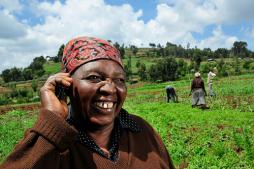agricultural extension
Posted by EKStallings on Dec 16, 2011
ICTs for Agricultural Extension: A Study in the Indian Himalayan Region data sheet 344 Views
Author:
Kameswar, V.L.V, Devash Kishore, Vinita Gupta
Abstract:
This paper reports on the availability, use and information seeking behaviour of a farming community with specific reference to Information and Communication Technologies (ICTs). It fills a research gap by examining what people do with a medium when they have access to it, rather than looking at barriers surrounding the use of ICTs and digital divide issues arising due to differential access and capabilities. The study was conducted in a state in North India, and provides insights into intentions and factors surrounding the use of various media by farmers. It highlights the socio-cultural context within which information seeking and use
Posted by EKStallings on Oct 06, 2011
Mobile phones may be one mechanism to increase effectiveness and efficiency for agricultural extension in low-income countries. Agricultural extension, broadly defined as the delivery of information to small-scale farmers, was developed to counteract information asymmetries suffered by farmers with limited access to information sources like landline phones, newspapers, radios and TV programming. This has meant that farmers have not been able to take advantage of innovations in agricultural production (from seed types to information about pest control or crop rotations) and have been largely unable to increase their yields and hence incomes.
While agricultural extension programs have tried to counteract this lack of information, they have also been long plagued by lack of scale, sustainability, relevance and responsiveness. Mobile phones, with their low-cost and capability for quick communication, may resolve many of these obstacles.
Dial “A” for Agriculture: A Review of Information and Communication Technologies for Agricultural Extension in Developing Countries, by Jenny C. Aker, a well-known researcher in the field, provides a broad overview of the shift toward using mobile phones in extension services and offers critical guides for assessing the effectiveness of such programs.
Half a century ago, extension programs were conceived to fill the glaring gap between agricultural innovation and crop yields. Despite great advances in agricultural innovations in the latter part of the twentieth century, farmers in Latin America and especially Sub-Saharan Africa have only seen slight increases in yields. Extension programs,which have largely taken the form of in-person visits and training, have consistently suffered from questions of cost-effectiveness.
Posted by EKStallings on Oct 04, 2011
Dial "A" for Agriculture: A Review of Information and Communication Technologies for Agricultural Extension in Developing Countries data sheet 1477 Views
Abstract:
Agriculture can serve as an important engine for economic growth in developing countries, yet yields in low-income countries have lagged far behind those in developed countries for decades. One potential mechanism for increasing yields is the use of improved agricultural technologies, such as fertilizers, seeds and cropping techniques. Public-sector programs have attempted to overcome information- related barriers to technological adoption by providing agricultural extension services.
While such programs have been widely criticized for their limited scale, sustainability and impact, the rapid spread of mobile phone coverage in developing countries provides a unique opportunity to facilitate technological adoption via information and communication technology (ICT)-based extension programs.
This article outlines the potential mechanisms through which ICT could facilitate agricultural adoption and the provision of extension services in developing countries. It then reviews existing programs using ICT for agriculture, categorized by the mechanism (voice, text, internet and mobile money transfers) and the type of services provided. Finally, we identify potential constraints to such programs in terms of design and implementation, and concludes with some recommendations for implementing field-based research on the impact of these programs on farmers’ knowledge, technological adoption and welfare.
Posted by MohiniBhavsar on Oct 12, 2010
Mobile Phones and Development: An Analysis of IDRC-Supported Projects data sheet 3137 Views
Author:
Ahmed T. Rashid and Laurent Elder
Abstract:
In the context of the rapid growth of mobile phone penetration in developing countries, mobile telephony is currently considered to be particularly important for development. Yet, until recently, very little systematic evidence was available that shed light on the developmental impacts of mobile telecommunication. The Information and Communication Technology for Development (ICT4D) program of the International Development Research Centre (IDRC), Canada, has played a critical role in filling some of the research gaps through its partnerships with several key actors in this area.
The objective of this paper is to evaluate the case of mobile phones as a tool in solving development problems drawing from the evidence of IDRC supported projects. IDRC has supported around 20 projects that cut across several themes such as livelihoods, poverty reduction, health, education, the environment and disasters. The projects will be analyzed by theme in order to provide a thematic overview as well as a comparative analysis of the development role of mobile phones. In exploring the evidence from completed projects as well as the foci of new projects, the paper summarizes and critically assesses the key findings and suggests possible avenues for future research.

